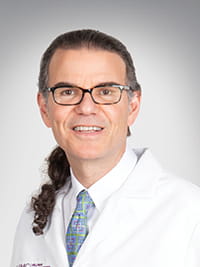
1/30/2023
PITTSBURGH — New research challenges the prevailing hypothesis for how donor stem cell grafts cause graft-versus-host disease, or GVHD, and offers an alternative model that could guide development of novel therapies.
Published today in Immunity, the study showed in a mouse model that GVHD, which often affects the skin, gut and liver, is maintained by donor T cells that seed those tissues soon after transplant and not by the continual recruitment of T cells from the blood as previously thought.
 “This study changes the paradigm of how people think about GVHD,” said co-senior author Warren Shlomchik, M.D., professor at the University of Pittsburgh School of Medicine Department of Immunology and the Thomas E. Starzl Transplantation Institute and director of the Hematopoietic Stem Cell Transplant and Cell Therapy program at UPMC Hillman Cancer Center. “It provides important mechanistic detail about what’s going on in the tissues affected by GVHD, which could ultimately inform the development of better therapeutics and lead to better outcomes for stem cell recipients.”
“This study changes the paradigm of how people think about GVHD,” said co-senior author Warren Shlomchik, M.D., professor at the University of Pittsburgh School of Medicine Department of Immunology and the Thomas E. Starzl Transplantation Institute and director of the Hematopoietic Stem Cell Transplant and Cell Therapy program at UPMC Hillman Cancer Center. “It provides important mechanistic detail about what’s going on in the tissues affected by GVHD, which could ultimately inform the development of better therapeutics and lead to better outcomes for stem cell recipients.”
Allogeneic stem cell transplantation involves infusion of stem cells from a healthy donor’s blood or bone marrow to a recipient. While often lifesaving for patients with leukemia and other blood disorders, the treatment also comes with a risk of developing GVHD, a life-threatening disease that occurs when donor alloreactive T cells attack the recipient’s healthy tissues.
According to a widely held theory, GVHD is maintained by T cells that continually migrate from secondary lymphoid organs throughout the body — including the spleen and lymph nodes — to affected tissues via the blood.
 However, a different model posits that the disease is maintained locally by T cells in the tissues with little input from the blood. In the new study, Shlomchik, lead author Faruk Sacirbegovic, Ph.D., research assistant professor of surgery at Pitt and the Thomas E. Starzl Transplantation Institute, and their team investigated the two hypotheses for how GVHD is sustained in tissues.
However, a different model posits that the disease is maintained locally by T cells in the tissues with little input from the blood. In the new study, Shlomchik, lead author Faruk Sacirbegovic, Ph.D., research assistant professor of surgery at Pitt and the Thomas E. Starzl Transplantation Institute, and their team investigated the two hypotheses for how GVHD is sustained in tissues.
The researchers developed a system to track alloreactive T cells in a mouse model of GVHD by labelling individual cells with unique tags to create different T cell “flavors.” By measuring the tags over time, they monitored where the T cells traveled and replicated.
The analysis showed that each tissue affected by GVHD had unique T cell populations with varying frequencies of each T cell flavor.
“This finding is strong evidence that the disease is locally maintained by T cells in each of the tissues,” explained Shlomchik, who also holds the Pittsburgh Foundation chair in cancer immunology. “If tissues were constantly getting T cells from circulating blood, then the frequencies of T cell flavors in each tissue should become more and more alike over time — but we didn’t see that.”
 Led by co-senior author Thomas Höfer, Ph.D., division head of the German Cancer Research Center and professor of theoretical systems biology at the University of Heidelberg, the team used mathematical models to predict that progenitor T cells seed out into recipient tissues early after transplant, differentiating there into disease-causing cells.
Led by co-senior author Thomas Höfer, Ph.D., division head of the German Cancer Research Center and professor of theoretical systems biology at the University of Heidelberg, the team used mathematical models to predict that progenitor T cells seed out into recipient tissues early after transplant, differentiating there into disease-causing cells.
Sacirbegovic next performed a series of experiments to confirm this prediction and identified these progenitors as T cells expressing a gene called Tcf7.
“We think that progenitor T cells are long-lived in target tissues and are critical for maintaining GVHD,” said Sacirbegovic. “After the initial seeding phase, the disease is mostly sustained within the tissue itself without a lot of input from new T cells in the blood.”
Stem cell recipients are typically treated with immunosuppressants to prevent and treat GVHD. As these powerful drugs act systemically to suppress the immune system, they also lower immunity to infections and have other side effects.
According to the researchers, the study’s insights could eventually lead to new, targeted therapies for GVHD.
“Now that we know the identity of progenitor cells, we might be able to prevent them forming early post-transplant or target them directly after they’ve formed,” said Shlomchik. “The findings also suggest that treating GVHD in the tissues themselves would be effective — although targeting tissues beyond the skin remains a challenge.”
With better ways to minimize the risk of GVHD after stem cell transplantation, the procedure could become more widely used to treat a broader range of diseases, including blood disorders such as sickle cell anemia and autoimmune diseases such as lupus and multiple sclerosis.
Other authors who contributed to this research were Matthias Günther, Ph.D., Alessandro Greco, M.S., and Xi Wang, Ph.D., all of the German Cancer Research Center and the University of Heidelberg; Daqiang Zhao, M.D., Ph.D., Meng Zhou, Ph.D., Sarah Rosenberger, M.S., Martin H. Oberbarnscheidt, M.D., Ph.D., all of Pitt; Werner Held, Ph.D., of the University of Lausanne; and Jennifer McNiff, M.D., and Dhanpat Jain, M.D., both of Yale University.
This work was supported by the National Institutes of Health (R01 HL143349), Marie Skłodowska-Curie Actions (764698) and the Swiss National Science Foundation (310030_200898).
PHOTO DETAILS: (click images for high-res versions)
First photo:
CREDIT: UPMC
CAPTION: Warren Shlomchik, M.D., professor at the University of Pittsburgh School of Medicine Department of Immunology and the Thomas E. Starzl Transplantation Institute and director of the Hematopoietic Stem Cell Transplant and Cell Therapy program at UPMC Hillman Cancer Center
Second photo:
CREDIT: University of Pittsburgh
CAPTION: Faruk Sacirbegovic, Ph.D., research assistant professor of surgery at the University of Pittsburgh School of Medicine and the Thomas E. Starzl Transplantation Institute
Third photo:
CREDIT: Thomas Höfer
CAPTION: Thomas Höfer, Ph.D., division head of the German Cancer Research Center and professor of theoretical systems biology at the University of Heidelberg
















